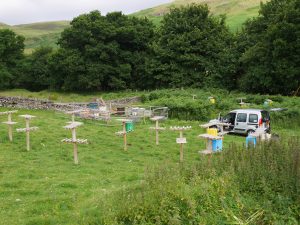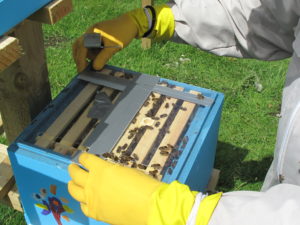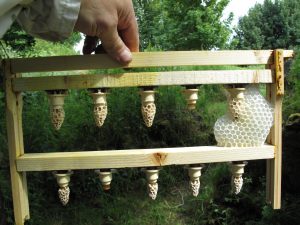Ochil Hills Bee Breeding Group
A group of us have been trying to select our best native or near native bees for several years but had found it increasingly difficult with the increase in importations of non-native bees. Uncontrolled matings meant that it was difficult to select for good characteristics as the outcomes were so unpredictable. We decided that a remote mating apiary was our best bet and with the help of a few beekeepers from the Fife, Tayside and Stirling areas located a suitable site in the Ochil Hills. We established a short-lived larger group under the name of the CESBBG (Central and East Scotland Bee Breeding Group) but only a small informal group continued with concrete action.
![]()
![]()

We set to with enthusiasm in late spring 2014. Sheep in the field meant the main drone rearing hives had to be fenced off and the mininucs placed on raised platforms attached to sturdy posts. The group examined colonies at apiaries in Fife and Tayside to identify suitable stocks of native or near-native dark bees. The beekeepers involved had already been selecting their bees for a number of years from different Scottish sources so ensuring a varied genetic background.
Dark body colour, narrow tomenta, longer body hair and drone colour were used to select accepted characteristics of Apis mellifera mellifera. In some cases in our first year we also used wing morphometry to exclude the more hybridised stocks from the breeding programme. We also placed great importance on the assessment of the best behavioural features. We especially looked for docile stocks which had performed well in previous years, had not readily swarmed and had wintered well.
The first year had several successful matings with dark queens going on to head new colonies with very few producing obviously hybridised workers. We had taken care to check for other beekeepers in the valley leading to the remote mating site and found none at the time. Grafting was usually done at our own apiaries but occasionally on site from colonies at the mating apiary. Various colony preparations were used for starting and finishing cells including the Vince Cook, Clarke Board, queenless stock and queenright (Wilkinson and Brown) methods. When preparing mininucs for the mating apiary we were careful to exclude unwanted drones. In the first year we used Apideas and also several Kieler mating nucs but during 2015 and 2016 moved to MiniPluses (Lyson, Abelo) with some adaptations of our own which were easier to manage at this elevated site.


These 3 years have not been easy with poor summer weather and learning to cope with local forage and pollen availability. We are in the process of changing to another remote site which is likely to have better shelter and more areas where queens may get mated. We plan to have more separation of mating nucs and drone rearing colonies with additional colonies to ensure surrounding areas are flooded with our chosen drones. This venture will continue with renewed enthusiasm for 2017 and beyond and build on experience gained so far.
Jeff Baxter
Gavin Ramsay
John Durkacz
